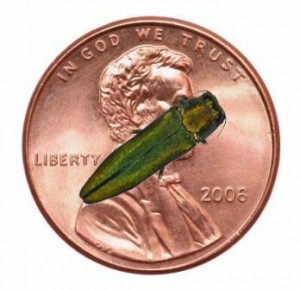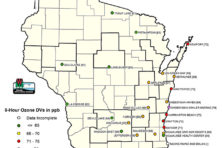An Unwanted Visitor
- Share
- Tweet
- Pin
- Share
Door County residents are known for their hospitality, giving up their time and home each summer to thousands of visitors. This summer, however, people across the Door Peninsula are trying to keep one visitor out. The Emerald Ash Borer (EAB), an invasive species of beetle recently found in Brown County for the first time, could do serious damage if it spreads to the peninsula
According to a press release from the Wisconsin Department of Agriculture, Trade, and Consumer Protection, an adult Emerald Ash Borer was found July 23 on public property near the Fox River, approximately one mile south of Green Bay.

The Emerald Ash Borer. Image from www.emeradashborer.wi.gov.
“It was found in a trap on a tree that appears perfectly healthy,” says Bob Bultman of the Door County Invasive Species Team. The trap in which the beetle was found is a box scented and colored to attract male ash borers by simulating the color and smell of a female during mating season. The purple sticky traps are placed about once every square mile in Brown County.
The EAB first reached the United States near Detroit in 2002, believed to have spread through trade with China. Since then, it has spread across 11 states and two Canadian provinces, and killed millions of ash trees through the tunneling of its larva. It first reached Wisconsin last summer in Newberg, and Brown County marked the fifth Wisconsin county with confirmed ash borers.
To try to stop the spread, officials are contemplating a quarantine of certain products in Brown County, which would limit businesses’ trade of firewood and other products that ash borers could stow away in. It’s hoped that quarantine could stop the EAB from spreading to Door County. According to the Wisconsin Department of Natural Resources, as much as 20 percent of the trees in Peninsula State Park are ash, and 15 percent of trees in Newport State Park.
“You remove 15 to 20 percent of your forest canopy, you open the rest of the canopy to wind damage,” says Bultman. “More light will get down to the floor, the weeds we don’t want will grow better…it’s a cascade effect; it will cumulatively damage our forests.”
Bultman and others have witnessed similar damage in recent years, and are trying to avoid a repeat.
“Dutch Elm Disease came [in the 1970s] and wiped out all our elm trees,” Bultman says. “And what did we do, we planted all ash.”
Those who made it are now regretting that decision. Brian Ferrie of Horseshoe Bay Golf Course also expressed concern.
“What I’ve seen in Door County, particularly in Horseshoe Bay, is a general decline in ash trees as a whole,” he says. “I think overall it tends to be kind of a weak species.”
Emerald Ash Borers could do surprising damage to golf courses. Ferrie says Horseshoe Bay’s course is fortunate to have few ash trees in play, but nevertheless fears for other courses.
“I think it’s extremely critical and extremely sad…there are golf courses that are going to be decimated because they have a significant population of ash,” he says. “But I see it being a greater issue for residential areas…we have a lot of wooded areas in Door County and I think it’s going to show up pretty quick.”
Experts haven’t found a way to root out Emerald Ash Borers before it’s too late. The borers and their larva can take up to five years to kill an ash tree, and the trees don’t show any signs of their demise until later in the process. Even so, Bultman wonders if officials are doing enough.
“Adult ash borer insects tend to live in the tops of the trees,” he explains. “Most of the [traps] hanging on the trees, they’re hanging near the bottom of the tree.”
Bultman stresses that everyone should take extra care to help stop the spread of all invasive species.
“Every tree has a potential problem that, if it isn’t here already, might be here someday,” he says. “The rule of thumb should be: firewood should never cross more than one county line.”
Although firewood isn’t the only way Emerald Ash Borers and other similar invasive species spread, it is the easiest way to control. Bultman explains that Door County’s popularity as a tourist destination doesn’t help it in this case, as many visiting campers bring firewood from out of town into state parks. Whether through tighter regulations on campers or just those campers being more careful, this practice must stop in order for Door County to have any hope of keeping the Emerald Ash Borer out.
“People need to care a little bit more is what it really comes down to,” Bultman says.


